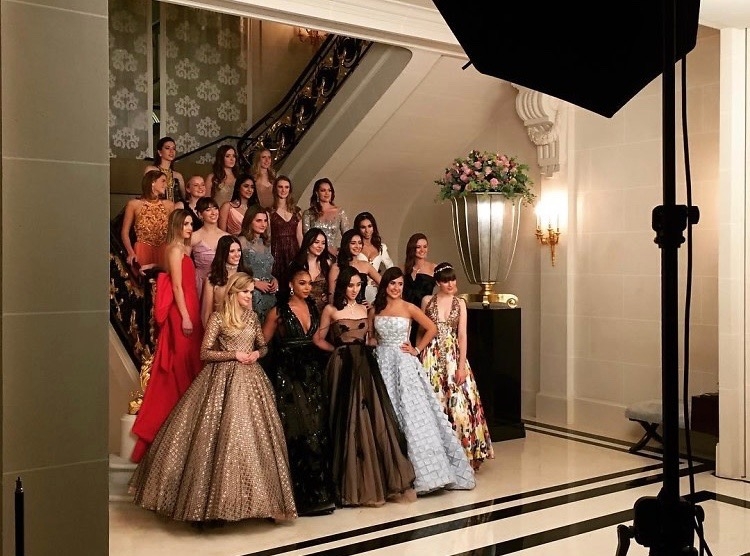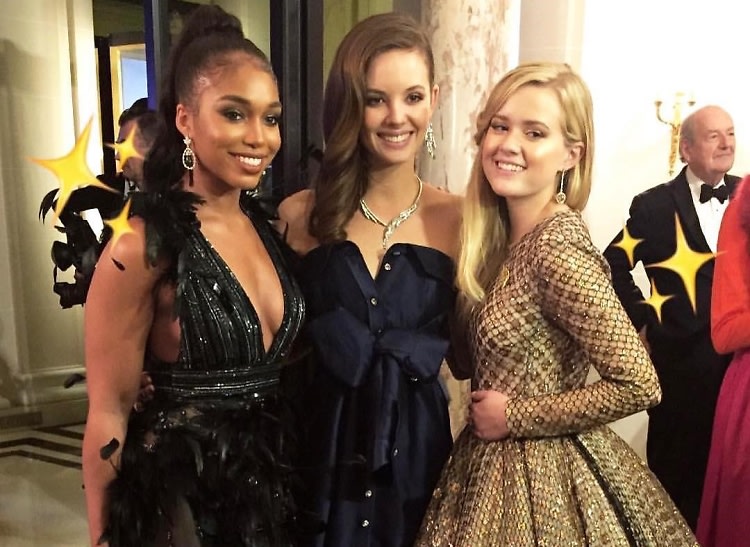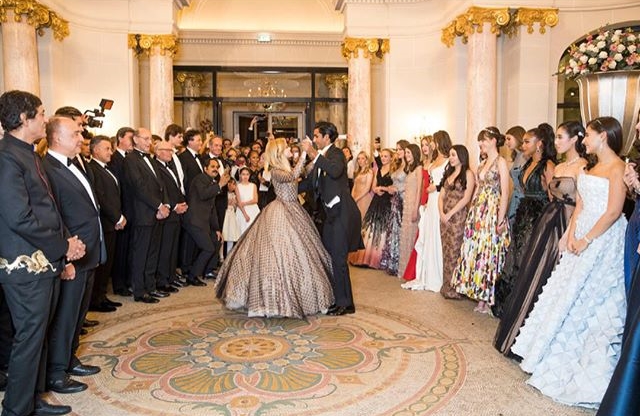The Belle of "Le Bal"

The annual Bal des Débutantes, recently held at The Peninsula Hotel Paris, showcased 21 girls in their late teens from wealthy, prominent families across the globe. The elaborate fête, commonly known as “Le Bal,” is a modernized version of traditional débutante balls where aristocratic daughters coming-of-age were presented to members of high society, and even royalty.
Le Bal’s modern adaptation still focuses on showcasing girls from high-profile families. However, Le Bal is promoted more as an elite social event that debuts young women into high couture fashion society. Normally filled with a handful of young, beautiful girls with famous names dressed in designer gowns, this year’s ceremony was no different. Ava Phillippe, the 18-year-old daughter of American actors Reese Witherspoon and Ryan Phillippe, stole the show (and much of the media coverage) in a Giambattista Valli Haute Couture ball gown and custom Payal Mehta jewels. Steve Harvey’s stepdaughter, Lori Harvey, also attended dressed in a feathery black Elie Saab gown.
Prior to coming to Paris, I had heard of Le Bal, largely due to the paparazzi craze that follows these young daughters of celebrities back in the U.S. However, in the northern part of the country where I come from, débutante balls were not part of my normal vocabulary, except perhaps as a concept in my mind of what pre-Civil War times were like in the South, à la Scarlett O’Hara in Gone with the Wind. Reading more about the event in the news this week piqued my interest and curiosity as to why this antiquated tradition of parading young women around like decorated cattle still exists and why event organizers are trying to perpetuate this outdated ritual by “modernizing” the concept. In a year of Wonder Woman, #MeToo empowerment, and almost having our first U.S. female president, why are we continuing to look backward in history and not forward when it comes to women?
Lori Harvey, Lily Webster, Ava Phillippe at the 2017 Le Bal, Image Credit: GuestofaGuest
History of Débutante Balls
Coming from the French word meaning “to debut” or “to lead off”, the tradition of débutante balls originated in the U.K. where, as early as the 1600s, aristocratic and noble families would present their teenage daughters to the King and Queen at court. The young women were then considered approved members of high-society and could start to attend additional social events. During the 18th century, the tradition continued in upper-class European families, but the balls’ main purpose started to shift towards finding marriage prospects for the debutantes. Usually dressed in all white, the women were formally presented by their fathers to a ballroom of eligible bachelors of similar social status.
The tradition was carried over from England to the U.S. prior to the American Revolution, under the alternative name of “cotillion.” In the absence of a monarchy, the American adaptation became more of a dance event, with the sole function of giving wealthy families a platform to announce the availability of their daughters to be married. Cotillions and debutante balls carried on into the 20th century until 1958, when Queen Elizabeth II abolished the ritual in England due to corruption and misrepresentation of social status. At the time, women who wanted to be seen as "high society" but didn’t have the connections or title to be officially invited to the balls attempted to buy their way in. Ball organizers took advantage of the system by charging increasingly higher fees.
Débutante balls began to lose their prominence in the 1960s and 1970s, in both Europe and the U.S., as the counter culture and women's liberation movements made the concept seem irrelevant and outdated. Over the last 30 years, however, there has been a resurgence of “modernized” debutante balls and many upper-class college-aged girls now idolize attendance at these glorified versions of proms. The most famous one in the U.S. is the International Débutante Ball, held at the Waldorf Astoria Hotel in New York every December. Families pay $14,000 per table and often up to $10,000 for the girl’s dress. However, the crème de la crème of débutante balls is “Le Bal” in Paris.
Débutantes from a ball in the 19050s, Image Credit: International Débutante Ball
The “New Deb”
Given the history of débutante balls, I expected Le Bal to be a long-standing French tradition, starting back to maybe the early 1900s or earlier. I was surprised to discover Le Bal is only 25 years old, created in 1992 by French PR executive Ophélie Renouard with the goal of modernizing the event with the invention of the “new deb.” In contrast to many of the more traditional cotillions and débutante balls, Le Bal is invitation-only and participants cannot buy tickets to attend. Each year, Renouard scours society pages across the globe in attempt to find approximately 20 young women in their late teens from renowned families. Some debutantes belong to royal and aristocratic families, others are the daughters of celebrities, business moguls, and politicians.
Le Bal began as a simpler, casual affair in the early 1990s, with more of a cocktail party feel and less elaborate gowns. Once Mikimoto, the luxury pearl company, became sponsors in 1996, the event took off and flourished starting in 2000 when Lauren Bush, George W. Bush’s niece, attended and garnered world-wide attention and publicity for the event. Bush started a trend by attracting other prominent political families such as Xenia Gorbacheva, Mikhail Gorbacheva's granddaughter in 2001, followed the next year by Silvio Berlusconi's daughter, Barbara. Celebrities and Hollywood stars soon followed, with some of the more notable participants in the past ten years including: Scout and Tallulah Willis with Bruce Willis, Autumn Whitaker with Forest Whitaker, Sophia Rose Stallone with Sylvester Stallone, Kyra Kennedy with Robert Kennedy Jr., and Bea Shaffer with her mother, Anna Wintour.
The annual event, held on Thanksgiving weekend, starts with a presentation of the débutantes, followed by a dinner, then the ball. Each girl wears a dress by a different haute couture designer, with costs upwards of $40,000. A "cavalier" escorts each débutante, which can be by a young man of her own choosing or chosen by the organizers of Le Bal. One lucky (and usually famous) débutante is chosen to open the dance with a waltz, usually led by her father. This year, Ava Phillipe earned that honor, accompanied by her cavalier, Maharaja Padmanabh Singh of Jaipur, a polo player on India’s national team. The opening dance is followed by a waltz with all of the fathers and debutantes, followed by a dance with the cavaliers, and eventually the waltz is replaced with more contemporary music and a live band.
Ava Phillippe leading the opening waltz at the 2017 Le Bal des Débutantes with Maharaja Padmanabh Singh, Image Credit: Got Celeb
So Last Season
Le Bal has been lauded as “one of the top 10 social events in the world,” according to Forbes magazine. This resurgence of popularity in débutante balls over the past two decades can largely be linked to an increased prevalence in pop culture, as portrayed on teen-cult TV shows like Gossip Girl and The O.C. And even though the attendees at these modern-day versions may recognize the triviality of cotillions and débutante balls, the newfound popularity has young girls still rushing to attend. Caroline Dunn, a young woman who attended The Débutante Cotillion and Christmas Ball (Infirmary Ball) at the in 2017 admits, “It’s more than a little strange participating in a tradition that essentially says: ‘Hello, society has approved you! Now you’re eligible to get married!’ in the 21st century. Yes, it’s a little elitist, not particularly feminist, and antiquated.”
But when asked to describe the modern-day débutante, organizers of these balls frequently highlight their purpose to raise money for charities as well as point out that the new débutante balls are less about presenting young women coming of age for social status or marriage purposes, and more about their introduction to the world of high fashion. As Le Bal’s website proclaims, “Of course now, due to Facebook and other social media, the Debs need not to make their social débuts, Le Bal is rather the unforgettable moment of their couture and media premières.”
While many of these balls do raise funds and create awareness for charities, sentiments like these show how out-of-touch the organizers of these events are with the reality of most young women in today’s times. How many teenage girls do you know that are worried about their “couture and media premieres”? It exposes a thinly veiled PR guise for the real purpose of the continuance of this antiquated tradition: for famous, rich people to display their wealth and celebrity status through their offspring by creating the next generation of “It Girls.”
Like another antiquated tradition — beauty pageants— débutante balls and cotillions perpetuate ceremonies of parading young, beautiful women around as objects to display to the world, lauded mainly for their physical beauty and their choice of a pretty ball gown. While one can maybe recognize the aspirational tone and fantasy components that exist in these ceremonies, unrealistic representations of the roles women “should” play in society like these not only bolsters our celebrity-obsessed culture, it can also be harmful to girls’ self-images and self-esteem. For example, though Le Bal totes the importance of the charitable contributions, lifelong friendships formed by participants, and the opportunity to meet other young men and women from all around the world through attendee participation, Renouard was still quoted as saying, "The main criterion for a girl is that she can squeeze into a sample couture ball gown."
In other words, modern-day Cinderella’s fairy godmother better be one heck of a seamstress.










